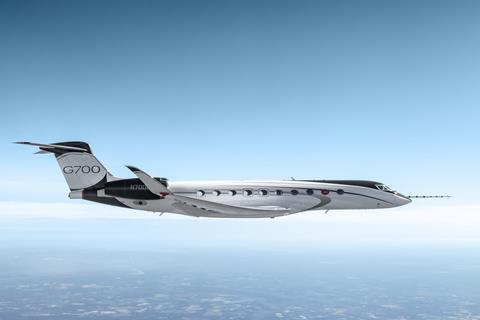After earning a $195 million profit in the second quarter, General Dynamics’ aerospace division – which is anchored by business jet maker Gulfstream – is preparing to boost deliveries in the second half in response to improving demand.
The company is also working through a G700 certification programme that General Dynamics chief executive Phebe Novakovic describes as “difficult”, though she insists Gulfstream’s large-cabin flagship remains on track for service entry in late 2022.

The G700’s certification challenges centre on its Rolls-Royce Pearl 700 powerplants, she said during General Dynamics’ second-quarter earnings call on 28 July.
The aerospace business’s $195 million second-quarter operating profit is 23% more than its $159 million profit in the second-quarter of 2020, despite revenue slipping 18% year on year, to $1.6 billion.
Gulfstream had trimmed production during the Covid-19 pandemic, with output reaching a low in the second quarter.
Gulfstream delivered 21 aircraft – including 18 large-cabin and three mid-cabin business aircraft – in the three months ended 30 June, down from 32 in the same period of last year.
But Novakovic describes second-quarter aerospace orders as remarkably strong and says production will climb in the second half of 2021.
“You will see more deliveries, revenue and operating earnings in the second half as a result,” she says.
General Dynamics expects Gulfstream will deliver 32 aircraft in the third quarter and 37 in the fourth.
“If all goes well, we may be able to bring in a few more forward from the first quarter [of] 2022 to meet current demand,” Novakovic says.
The Savannah-based airframer has now completed some 1,600h of testing on its five G700 test aircraft, a flagship aircraft that Gulfstream launched at the NBAA business aviation show in October 2019.
Though progress continues, Novakovic notes that “much remains to be accomplished, particularly with respect to the certification of the new Rolls-Royce engine”.
Asked to elaborate, Novakovic says that “new engine development programmes…are always difficult to get through certification”.
“But at the moment, we don’t have any particular issues that would impact our overall estimation of timing,” she adds.
The 18,250lb-thrust (81.2kN) Pearl 700s share the Pearl engine family’s core but are designed specifically for the G700. The powerplant features a blisk fan, a 10-stage high-pressure compressor, a new low-pressure system and a new nacelle.
With advertised range of 7,500nm (13,890km), the G700 competes against Bombardier’s Global 7500.


























